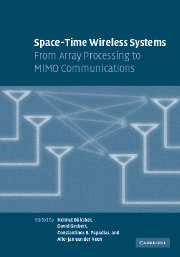Book contents
- Frontmatter
- Contents
- List of contributors
- Acknowledgments
- Introduction
- Part I Multiantenna basics
- Part II Space-time modulation and coding
- 7 Introduction to space-time codes
- 8 Perspectives on the diversity-multiplexing trade-off in MIMO systems
- 9 Linear precoding for MIMO channels
- 10 Space-time coding for noncoherent channels
- 11 Space-time coding for time- and frequency-selective MIMO channels
- Part III Receiver algorithms and parameter estimation
- Part IV System-level issues of multiantenna systems
- Part V Implementations, measurements, prototypes, and standards
- Index
9 - Linear precoding for MIMO channels
Published online by Cambridge University Press: 25 February 2010
- Frontmatter
- Contents
- List of contributors
- Acknowledgments
- Introduction
- Part I Multiantenna basics
- Part II Space-time modulation and coding
- 7 Introduction to space-time codes
- 8 Perspectives on the diversity-multiplexing trade-off in MIMO systems
- 9 Linear precoding for MIMO channels
- 10 Space-time coding for noncoherent channels
- 11 Space-time coding for time- and frequency-selective MIMO channels
- Part III Receiver algorithms and parameter estimation
- Part IV System-level issues of multiantenna systems
- Part V Implementations, measurements, prototypes, and standards
- Index
Summary
Precoding versus coding
A pivotal function of the physical transmission layer is that of making available a linear space of functions that meet transmission constraints. Each dimension of the coordinate system used in this space is called one degree of freedom. Except when orthogonal waveforms are used, the number of modulation waveforms is greater than the number of degrees of freedom. The transmission of a signature waveform colinear with one dimension is what is commonly referred to as one channel use. The constraints in designing modulation signals for MIMO systems are the classic ones: the transmit power is limited and the signals used should have their energy concentrated in a predefined window in time and frequency. The latter pair of constraints are coupled and the number of orthogonal signals with finite bandwidth-time product (WT) that can be constructed is ≤ WT. The formal statement of this fact is generally attributed to Gabor (1946).
Ideally, the selection of the signal space should be in continuous time and space. In practice, the digital to analog converters and antenna arrays and the RF propagation channel transduce the digital stream into signals with undesired properties. The transceivers' frontends can transform digitally the coordinate into a more suitable system of coordinates compared with that determined by the physical transducers. The linear mapping that establishes the new set of coordinates is referred to as linear precoding and its design can be carried out in discrete time (see Section 9.2 and Scaglione et al., 1999).
Information
- Type
- Chapter
- Information
- Space-Time Wireless SystemsFrom Array Processing to MIMO Communications, pp. 178 - 197Publisher: Cambridge University PressPrint publication year: 2006
